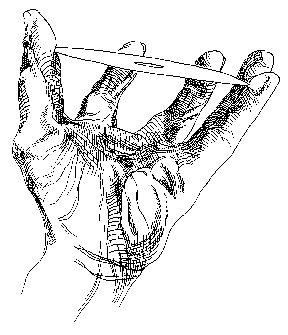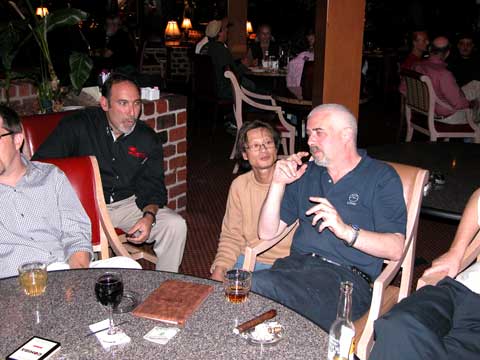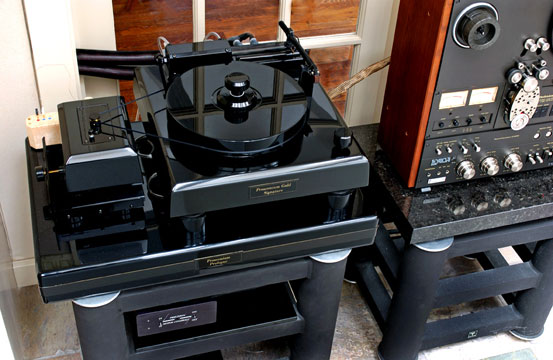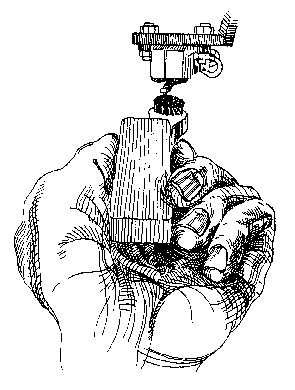|
You are reading the older HTML site
Positive Feedback ISSUE
17
Evolution of a Source
Photographs and image processing by Albert Porter and David W. Robinson; drawings by Bruce Walker Of Open Reels, LPs, and Turntables Looking back on all the years I spent evolving my audio system, my determination to find the best possible music playback source was the most important decision I ever made. My first purchase was based not only on the need to reproduce music perfectly, but also to do as little damage as possible to my growing software collection.
When I began, there were really only two audiophile music sources, the modern LP and open reel tape. Since rock and popular music was released first (and sometimes only) on LP, it reduced that decision to finding the best turntable. So, before deciding on proper amplification or even dreaming of the perfect speaker, my first purchase would be a Thorens TD 124 turntable, Ortofon RS 212 tonearm and Ortofon SL 15 moving coil cartridge. As a teenager with limited earnings, it took several months of hard work and saving every cent to gather five hundred dollars for this ultimate source. All my friends criticized me for my foolishness, wondering aloud why anyone would spend so much on a turntable when a complete stereo could be had for less. It was a lot of money. Today it seems like a small investment for "state of the art," high-end audio, but consider at that time a brand new Chevrolet Corvette could be had for less than $5,300.00, and premium gasoline to fuel it was 29 cents a gallon. For those who don't remember 29 cents a gallon, that price also provided you with full service from a station attendant who pumped your fuel, checked your engine oil and cleaned your windows while you sat in the driver's seat, enjoying a song on the radio. (Where is that time machine when we need it?) Encouraged by the performance this fine source provided, I upgraded that original Thorens the next year to the "improved" Thorens TD 124 series II. This time the turntable was fitted with the legendary SME 3009 tonearm, and another Ortofon MC cartridge. Shortly afterward, the little "plastic fantastic" Acoustic Research turntable shook the high end audio world by offering a great turntable with tonearm for only $69.00. This forced everyone to convert their turntable designs to belt drive, and Thorens joined the fray with the model TD 125. My first belt drive experimentation began with this Thorens TD125, and as it happens, this was also the first table I experimented with in earnest in search of the perfect tonearm. Finding employment in a high end audio store certainly helped. I was able to audition most of the popular tonearms from new stock and also from what we took in on trade. I eventually settled on the rather unconventional Rabco SL 8E, later adding my own electrical and mechanical modifications. At that time the Rabco represented state-of-the-art performance, and one of the few (if not the only) true linear tracking vinyl playback systems in the world. Shortly afterward, the European and American turntable manufacturers found themselves facing competition from a spate of superb Japanese builders, among them Technics and the Lux Corporation. I remember the first time I laid eyes on the beautiful Luxman model PD 121, a direct drive turntable. I knew I had to own it, attracted not only to the concept of direct drive, but also its superb style, fit and finish. With my finances in better order, I was able to purchase a pair of these, and placed them beside each other on identical stands. This allowed me to experiment with multiple high-end tonearms for another year and a half. When all was done I had returned full circle, back to the Rabco SL8. Over time, I also experimented with several versions of the Linn Sondek, the Townsend Rock and Excalibur arm, and eventually owned two identical VPI model HW 19 turntables. I auditioned the Linn Sondek and VPI HW 19 with many isolation devices and tonearms, and built a number of tonearm boards. These boards were made from various materials including MDF, Plexiglas, exotic hard woods, and even non-ferrous metals, all having a profound effect on the tonal balance and performance of the music.
The Linn Sondek LP-12 (photograph and fresco by Robinson) Among the arms used for these listening tests were the Carbon Fiber Pioneer, the Luster, the Dynavector 505, the Grace 707, the Eminent Technology, the Breuer Dynamic with Breuer MC cartridge, and Herb Papier's now famous Triplanar. There are music sessions that become defining moments, a listening experience that forces you to reevaluate your standards. That experience for me was my first audition of the Well Tempered. This is the product that piqued my interest in bearing design and proved the importance of utter silence. Until then, I had failed to realize the impact of (almost) imperceptible noise on the music, regardless of how signal to noise was rated in the specification sheets. This proved to me that more information could be retrieved from my existing LP library than I thought possible, and that analog hardware was still improving. Later, when Steve McCormack became the North American representative for Oracle, my attention was directed to this fine Canadian product, and I wound up owning every version that Oracle built, including the big Premiere. After the Premiere, I purchased the huge, crystal clear acrylic Win Labs, along with its matching Win Labs strain gauge cartridge. I learned the meaning of dynamics and contrast from this big rig, but ultimately all of the strain gauge cartridges either failed to maintain proper channel balance, or died prematurely. I had always hoped for an ultimate design, a turntable that combined the finest elements from all that had come before it. My hopes became reality when John Bicht introduced the Versa Dynamics model 2.0, at the Chicago CES. It was the hit of the show, and was sporting a brand new moving coil cartridge from Switzerland called the Benz. This turntable was a "system," and in my opinion represents the first of the "super tables." The Versa combined a non-resonant chassis with a linear-tracking, air-bearing tonearm, and employed a vacuum hold down system for the LP that included a "software safe" Teflon mat. It also had a superbly-designed, silicone-dampened suspension system and a unique platter bearing. This "system" included an integrated stand specifically designed to work with THIS turntable. Constructed from thick wall, large diameter, non-magnetic aircraft grade aluminum, it was pre-filled from the factory with lead shot for proper ballast. It was a beautifully grained finish, and was painted with gray Nextel. Each of the four legs had an integral, adjustable stainless steel spike for coupling and leveling. To tell you the truth, I would have never considered selling this turntable, except for the fact that John Bicht closed up shop, forcing me to pursue alternatives that were still in production. I went on to purchase a Basis Debut Gold IV, and after a couple of years upgraded to the Debut Gold V. Various tonearms were fitted to these two tables, including three models from Bob Graham, and the Air Tangent 10B from Sweden. The Air Tangent was the arm that should have returned to me everything I lost when I sold my Versa Dynamics. It was hand made from superb materials, featured an adjustable valve to control air pressure for the arm bearing and a VTA that was adjustable on "the fly." It offered the sonic magic inherent in all linear trackers, but tonally was a severe compromise in the mid-bass and deep bass region, especially when compared to the Graham and Versa tonearms. It seemed I would never find my "perfect" source. The Digital Side Speaking of "perfect source," I must mention my pursuit of digital; it was an important part of this evolution. My digital search began before my Well Tempered, and long before the Versa Dynamics or Basis Debut Gold.
In early1984, the Compact Disc was introduced into our market, and I was one of the first to convert. I was drawn to the compact size, convenience and the promise of "perfect sound forever." This, I thought, would finally make things simple! I could enjoy my music with no records to wash, no needle to clean, and no wear on my precious (soon to be acquired) digital music library. First I needed an "audiophile" CD player, and the Meridian was the unit being favorably reviewed by the audio press. I purchased one at near full retail and then proceeded to buy every CD in sight. The people at Peaches Records began to recognize me. When they received a new shipment of Compact Discs I was there, going through the bins. I bought a lot of titles I really didn't need, just so long as I could own it on Compact Disc. I was certain this leap in technology would end my quest for the perfect turntable and arm. This format was new and would get better every year, right? I acquired over 1500 titles before I even began to slow down. Over the twenty year period that followed that first purchase, I continued my search for "the perfect" source. Certain digital had the right stuff. I swapped and upgraded dozens of players, transports and D to A converters, always comparing it to my existing LP library. In time, I began to refer to each new digital acquisition as another "Giant, Little Step." Every new piece of digital hardware was touted as the breakthrough system of the decade, superior to all other digital and equal or better than analog. "Amusing," I began to think; this was the format touted as "perfect" when it was introduced. After a few years, many of us realized digital was not making us happy. There was a lot of data missing and something strange was going on in the high frequencies, forcing us to cut our listening sessions short. I was spending much of my listening session, remote control in hand, skipping one track to the next, searching for the emotional content that once bound me to the music. Frustrated, I sold off all but a few hundred CD's; many were early pressings, so I have no regrets. Back to Analog Much of the tuning and tweaking of my system had been aimed at making digital sound acceptable when switching between it and LP's. Now focused exclusively on analog, I pushed the performance and resolution of my system further than ever, without fear of uncovering unpleasant artifacts in my CD's. As mentioned before, the Versa Dynamics model 2.0 was the source that pushed the limits of analog playback in my system, and I was hoping the analog evolution had not ended. Which brings me to Garth Leerer. I clearly remember him to this day, standing beside a Versa Dynamics turntable at "Music by The Sea", the retail high end audio store that Steve McCormack and Joyce Fleming began in the late 1970's in Leucadia, CA.
At the PFO table during the recent Rocky Mountain Audio Fest, October, 2004 (left to right): Garth Leerer of Musical Surroundings (black shirt), Tri Mai of Triplanar, and Brian Morris of Linn. [Photograph and image processing by Robinson] Garth was always devoted to music, and since those days has become well known as the man behind "Musical Surroundings." He is a very dedicated analog guy, and became my source when production stopped on the Versa Dynamics. At that time, Garth represented Basis, and I loved the straightforward design and elegant simplicity of A.J. Conti's products. I spent many hours on the phone with A.J., discussing photography, music and audio in general and eventually convinced him to build me an all black version of his Debut "Gold." (I have never been a fan of gold trim on either automobiles or hi-fi). The Benz Ruby moving coil cartridge traveled over from my Versa Dynamics and was my reference—until the day I auditioned a Koetsu Rosewood Platinum Signature. That instantly became my new favorite, and has remained so for all these years. Enter Lloyd Walker—and my dream turntable, the Walker Audio Proscenium! CES is not the ideal place to listen to music, but it's a great place to meet people. Having attended most of the shows in the last twenty years, some of the people you meet you NEVER forget. Ralph Karsten (Atma-Sphere) is one of these, Roger West (Soundlab) is another, and Lloyd Walker (Walker Audio) are but a few of the unforgettable folks that I've met over the years at that show. This particular CES, I met Lloyd Walker. He was showing a new, huge, black and gold turntable called the Walker Proscenium. It fascinated me, particularly the design of the linear track tonearm. It reminded me a bit of the Eminent Technology I once owned, and excited the pleasant memories of music with the Versa Dynamics, and those early days with the Rabco SL8E. Fascinated as I was with the Proscenium, I was unable to justify the price, particularly since I had just met him. I opted instead for the Walker motor controller, which he claimed would work on my Basis Debut Gold, improving its performance. The upgrade that the Walker motor controller provided for my Basis removed my doubts, however, and forced me to take Lloyd Walker and his Proscenium turntable seriously. Lloyd had indeed proven his point, so I committed to this very expensive source, provided he would make one compromise. It required more than a month of wrangling, but Lloyd finally agreed to build the Proscenium in all black finish, one of only two in existence, even to this day.
Albert Porter's Walker Audio Proscenium turntable (Photograph and image processing by Porter). I expected an upgrade, but this was an upgrade beyond anything I have ever experienced. I now had a new standard in silence. This is blacker than the Well Tempered, blacker than the Basis, even blacker than the Walker's custom black finish. This is a blackness BEHIND the music, deeper and darker than the black of digital, a fluid stream of music from "nothing" I never thought possible from analog. Blackness is important, but once you're over the shock, the absolute speed accuracy and a sense of limitless power to spin through the most complex passages still causes one to stand in awe of this product. There is no compression of dynamic range, no change in timbre and the soundstage remains the same depth and height, regardless of the complexity of the music. This is a remarkable accomplishment, and until I experienced it, did not know how much of a compromise everything before it had been. I often think about high end audio products in terms of the people and personalities that create them. I find it interesting that Lloyd Walker, John Bicht and myself are all old automobile racing guys. For anyone that has raced cars, particularly drag racing, there is no second place, only a winner and a loser. For that reason, Lloyd Walker is never content to leave well enough alone, and that is a valuable trait. Lloyd likes to describe each increment of adjustment and tweaking of the Proscenium in bold terms. Now there's no doubt that the Proscenium is highly adjustable; it's one of the most remarkable things about this turntable. The problem arises when people believe they are required to do these adjustments, just to make it work. Nothing could be further from the truth! When I first assembled my Proscenium, I was so eager to listen I made only preliminary adjustments. When the needle dropped and the music charged into my living room with the energy of a master tape, I was convinced I had made the right decision. Later, I did work in earnest to make all the micro adjustments necessary to achieve the ultimate performance the Proscenium is capable of. The good news is that once the overhang, azimuth and tracking are set and locked, it stays set FOREVER. By "forever," I mean "years and years without turning a knob, a screw, or measuring anything." I have owned my Proscenium for more than six years. It sees quite a bit of use, and all this time has passed without repairs or adjustments, other than leveling the turntable so that the arm operates properly. Leveling can be a frequent or infrequent adjustment, depending on the stability of your foundation. I perform a quick check at least once a month by keeping a ball of "DAP Fun Tack," equal to the tracking weight of the Koetsu RSP. I stick the "Fun Tack" onto the Walker tonearm's counterbalance weight, and the cartridge then hangs in space above the platter. If the table is level, the arm moves neither toward nor way from the spindle. If necessary, a turn of the leveling knob will put it right. No tools required; just enough light to view the results. This is no more effort than keeping the Symposium roller blocks under my CD player aligned. The results? Most of my LP library plays with no surface noise, due to the exceptional engineering of the Walker and my decision many years ago to protect my software. Deep in the grooves of my Beatles LPs, or my Jimi Hendrix, Axis Bold as Love, or Dave Brubeck's Time Out, or The Doors, Morrison Hotel, are hidden wonders of music that the Proscenium reveals—and all play as perfectly as if they were opened yesterday.
I believe the music has been waiting for this moment, safely living on in the grooves, archived to LP years ago when the master tape was new—waiting to be fully released by a stellar turntable design that could do it justice. Well, the ultimate turntable has evolved and has proven that analog was the right choice. The Walker Proscenium is a source so superb in my estimation that it finally satisfied a quest that began when I was teenage boy, wishing for perfection in LP playback and hoping my library would still be state of the art when I was a grown man. And, you know—it is.
|






